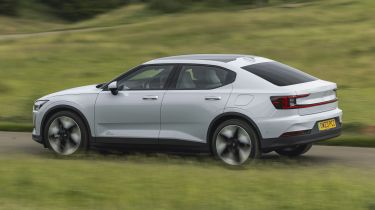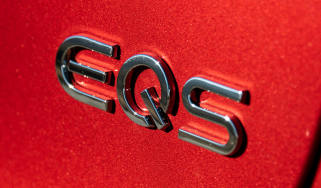Polestar 2 - Range, charging and running costs
The Polestar 2 now offers one of the longest ranges of any EV, while running costs remain low
The revised Polestar 2 now consumes up to nine per cent less energy, can travel up to 22 per cent further, and charges up to 34 per cent faster following a number of updates introduced in 2023. The headline-grabbing figure is the Long Range Single Motor model’s official WLTP range of up to 406 miles – an increase from the pre-facelift version’s 341 miles of range.
The range kicks off with the Standard Range Single Motor model, which can cover up to 339 miles before its 69kWh battery (67kWh useable) runs flat. Long Range models get a larger 82kWh battery (79kWh useable) for the headline range figure of 406 miles in single-motor guise, or 368 miles if you spring for the Dual Motor version – the latter can disconnect its front motor while cruising to help with efficiency. Adding the Performance Pack to the Dual Motor version drops the maximum further to 352 miles.
The Polestar 2 hasn’t proven to be the most efficient EV in our own testing, especially compared to its rivals Tesla and BMW, making its official range figures more difficult to achieve in the real world. Polestar’s updates have helped a little, because the refreshed Long Range Single Motor variant we drove as part of our company car group test indicated a range of 271 miles on a full charge and was the fourth most efficient with 3.3 miles per kilowatt hour. That’s some way off 406 miles stated in the official tests, but still pretty impressive.
More reviews
Car group tests
- Polestar 2 vs Tesla Model 3 twin test review: EV titans go head-to-head
- BMW i4 vs Polestar 2 vs Tesla Model 3: 2022 group test review
In-depth reviews
Long-term tests
Road tests
- New Polestar 2 Dual Motor Performance Pack 2024 review: flagship model packs a punch
- New Polestar 2 Long Range 2023 review
- New Polestar 2 BST Edition 270 review
- New Polestar 2 Standard Range Single Motor 2021 review
Used car tests
It’ll take a typical 7kW home wallbox roughly 10 hours to fully recharge the 69kWh battery in Standard Range Polestar 2s, and roughly 12 hours to do the same for Long Range versions with their 82kWh batteries.
The Polestar 2’s rapid charging capabilities aren’t the quickest compared with the Hyundai Ioniq 6, but base models will reach 135kW, meaning a 10 to 80 per cent top-up takes just 34 minutes. Meanwhile the rest of the range maxes out at 205kW, with the same charging session taking just 28 minutes if you find a suitably fast ultra-rapid charger.
The Polestar 2 costs more than the Tesla Model 3, but the Polestar 2’s starting price is lower than that of the BMW i4 and Ioniq 6, at least. Plus, it’s exempt from the London Congestion Charge and road tax (VED) until 2025 and will appeal to company car drivers thanks to its incredibly low Benefit-in-Kind (BiK) tax rating.
Insurance groups
Insurance ratings for the Polestar 2 vary depending on the battery and motor combo you opt for. The entry-level Standard Range Single Motor is in insurance group 40, while the Long Range Single Motor falls into group 41. The more powerful Polestar 2 Long Range Dual Motor lands in group 44, and the same goes for models equipped with the Performance Pack, which adds even more power.
The Polestar 2 won’t be the cheapest car to insure. In fact, the pricier BMW i4 will be less costly to cover because it attracts lower insurance ratings. The Tesla Model 3 will incur higher premiums because it occupies groups 48-50. The Tesla was judged by industry testers, Thatcham Research, to only offer ‘basic’ levels of protection for vehicle security, and so incurs higher insurance costs.
You can get personalised car insurance quotes fast with our comparison tool powered by Quotezone...
Depreciation
Data suggests the Polestar 2 after a three-year/36,000-mile period of ownership holds onto 41 to 49 per cent of its original value, with the Long Range Dual Motor versions delivering the strongest residuals.
In comparison, the Tesla Model 3 is expected to retain between 52 to 56 per cent, with the BMW i4 keeping between 50 and 55 per cent after the same 36 months of ownership.
To get an accurate valuation on a specific model check out our valuation tool...






